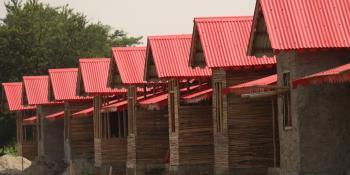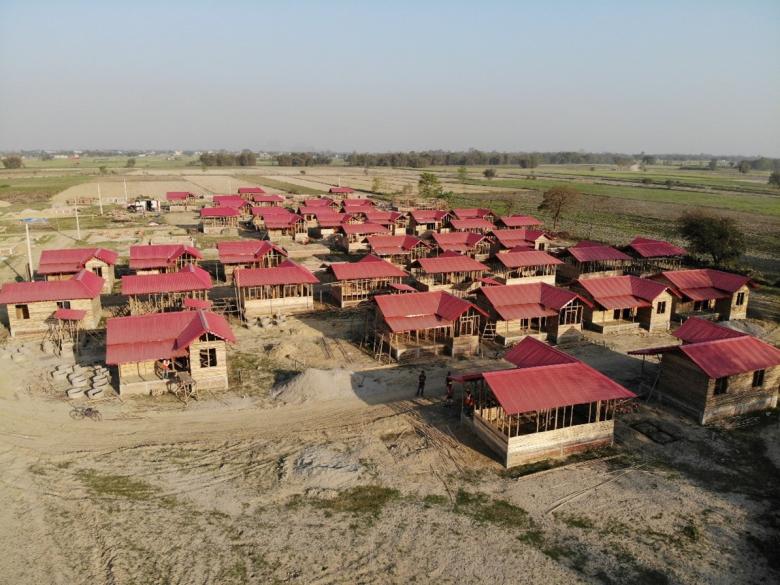
An innovative housing solution leads to new beginnings for families in Nepal
In Nepal’s Eastern Terai region, homes built with cement bamboo frame technology are creating new pathways to stability and security for families. “Nepal is one of the least developed countries in the world,” says Eliza Sthapit, national director of Habitat for Humanity Nepal. “Soaring land prices and rapid rural to urban migration are key causes for lack of access to affordable housing for most in urban Nepal. In rural Nepal, low economic opportunities, lack of proper education and infrastructure are key causes.”
Cement bamboo frame technology is an innovative building method that Habitat and the Hilti Foundation are working together to scale in Nepal and the Philippines. The technology was developed by Base Bahay Foundation, an organization founded by the Hilti Foundation. The homes built using this technology are constructed with specially treated bamboo and cement plaster that makes them disaster-resilient and sustainable.
Bamboo is already a popular building material for low-income families in Nepal, but more traditional building methods lack the structural integrity to withstand harsh weather conditions or disasters. “There are many benefits to building with cement bamboo frame technology,” says Luis Felipe Lopez, head of technology at Base Bahay Foundation. “The most important are that houses built using the technology are more resistant to earthquakes due to their low mass, experience 70% less carbon emissions than those using conventional construction systems and help create jobs in local communities.”
Joining together to create a better world

Photos by Abisek Bista
A multifaceted group of local and international partners are working together to scale the use of cement bamboo frame technology, including Habitat, Base Bahay Foundation, non-governmental organizations, financial institutions, local communities, masons, bamboo treatment centers, and federal and local governments. “Multisector partners have committed to working together with an infinite level of patience and respect for each other to make cement bamboo frame technology a viable building material of choice in the Eastern Terai,” says Eliza.
Habitat and the Hilti Foundation are also working on a cement bamboo frame technology project in the Philippines, which allows for the two countries to collaborate and learn from one another’s efforts. “Since the nature of work in Philippines resembles that of Nepal, we both learn from each other and present our learnings and discuss programmatic and technical uses,” says Pratik Singh Parmar, a project manager with Habitat Nepal.
Habitat Nepal also receives technical support from Base Bahay Foundation, which advises on best practices for local bamboo treatment centers, cost efficiencies in production and the development of human-centered designs that reflect local preferences while maintaining the integrity of cement bamboo frame technology construction.
Building a strong foundation
Part of Habitat Nepal’s work to advance the use of cement bamboo frame technology includes helping local governments and communities understand the benefits. “Bamboo is one of the only building materials that low-income families can afford to build with,” says Yuban Malla, program director at Habitat Nepal. “Given their financial constraints, they build with untreated bamboo that does not have much structural stability. These families often reside in disaster prone areas, and they are not only affected by heavy winds and fires but are also the first to be hit by floods.”
The cycle of low-income families having to rebuild with bamboo every few years has resulted in bamboo being regarded as a “poor family’s building material.” Habitat Nepal is working to change that perception by inviting community members and officials to visit the cement bamboo frame homes. The visitors can ask residents questions about their experiences with the homes’ durability. Habitat Nepal also advocates to change policies at both the local and federal level in favor of building with bamboo and works to secure government funding to build more homes.
Local governments will provide approximately 50% of cost share for the 500 homes that will be built using cement bamboo frame technology in Eastern Terai through the Habitat-Hilti Foundation partnership. During this building phase, Habitat Nepal plans to engage in market research and testing to engage potential homeowners, financial institutions that can provide loan options for treated bamboo housing solutions, and other important partners to gather data that supports a financially sustainable model that will help increase the availability of affordable housing.
Habitat and the Hilti Foundation are using a phased approach to address and support every aspect of the value chain that will be required to ensure a viable market for cement bamboo frame technology homes in Nepal long-term. “Ultimately, the goal is to scale the inventory of adequate and appropriate housing,” says Enid Madarcos, Habitat Asia-Pacific’s senior manager for urban, land and policy.
The Habitat-Hilti Foundation partnership is working toward the goal of cement bamboo frame technology becoming a self-sustaining industry in Nepal that operates independently and successfully within the country. In order to reach that goal, relationships with the local farming community must be strengthened to ensure the growth and harvest of high-quality bamboo, a sufficient number of treatment centers must be in place to efficiently process enough bamboo to meet demand, the construction workforce must be educated on how to properly build using cement bamboo frame technology and an informed customer base has to be motivated to purchase homes built with the technology.
Fostering dreams and new opportunities through innovative housing
“Home is a start to nurturing every small and big dream of an individual and families,” says Eliza. “By ensuring homes for families that are safe, durable, disaster-resilient and environmentally sound, the Habitat-Hilti Foundation project is contributing immensely to both socio-economic development and environmental sustainability in Nepal.”
Working together to bring innovative housing technologies like cement-bamboo frame technology to scale globally is essential to creating a world where everyone has a decent place to live. “In both Nepal and the Philippines, we are seeing how an innovative housing solution can make a life-changing difference for families,” says Johann Baar, director of affordable housing and technology at the Hilti Foundation and member of the Hilti Foundation executive board. “We are excited to continue to work together with Habitat and a diverse coalition of partners to promote housing and process innovations that have significant scale and impact.”

